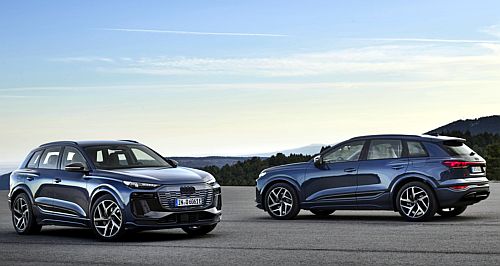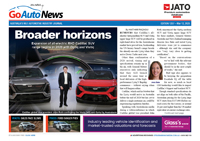Make / Model Search
Future models - Audi - Q6 - e-tronBattery electric Audi Q6 E-Tron emergesAudi BEV portfolio expands with reveal of Q6 and SQ6 E-Tron medium SUV duo19 Mar 2024 AUDI continues to build its fully electric portfolio with the new Q6 E-Tron and SQ6 E-Tron medium SUVs, the brand’s first production models built on parent company VW Group’s Premium Platform Electric (PP-E) underpinnings shared with the incoming Porsche Macan EV with others to follow.
In Australia, the newcomer will cross swords with a variety of premium electric SUVs in the low six-digit price bracket – besides its Porsche platform partner – including the BMW iX3 and Jaguar i-Pace, as well as potentially tempting people out of a top-spec Ford Mustang Mach-E or Kia EV6.
The Q6 and performance-oriented SQ6 mark the next step in Audi’s transformation toward is goal of becoming a “premium electric mobility provider”.
Audi says the new model “is defined not only by impressive driving and charging performance, but also by increased efficiency and long range”.
It channels current Audi sporty SUV styling cues refined to reflect E-Tron design language established with the smaller Q4 E-Tron, larger Q8 E-Tron and E-Tron GT sports sedan but moving the game on with what is said to be the world's first active digital light signature.
Measuring 4771mm long, 1993mm wide and 1648mm with a wheelbase of 2899mm, the Q6 is slightly larger than the Q5 with two seat rows and a five passenger capacity.
The interior features a three-dimensional and high-contrast design that deliberately places elements in the foreground or background to create a “spatial architecture” while Audi’s MMI panoramic display and the MMI passenger display form a visually clear digital “stage”.
According to Audi AG chair Gernot Döllner, the Q6 represents “the next technological leap in premium electric mobility for our customers”.
“The PP-E shows how we are pooling expertise within the Volkswagen Group and thus making electric mobility scalable. Thanks to the PP-E, we are able to launch high-volume models with high technical standards in different segments and thus further electrify our portfolio."
In a statement issued at the Q6-E-Tron international reveal in Ingolstadt last week, the brand said the flexibility of the PP-E helps give future models an independent character and typical Audi DNA despite shared technical underpinnings with other brands.
The Q6's electric motors are fed by a newly developed lithium-ion battery pack consisting of twelve modules and 180 prismatic cells with a total gross capacity of 100kWh (94.9kWh usable) for a claimed range of up to 625km.
Total system power output for the Q6 E-Tron is rated at 285kW, consuming electrons at the rate of 17.0-19.4kWh/100km (WLTP) while the SQ6 E-Tron has a total system output of up to 380kW with consumption claimed to be 17.5-18.4kWh/100km (WLTP).
Both run all-wheel drive for what Audi says are gains in terms of performance, range, charging, driving dynamics, and design. A more economical rear-wheel drive version is planned.
Performance figures for the Q6 E-Tron Quattro include a claimed 0-100 km/h sprint time of 5.9 seconds, with the SQ6 E-Tron cutting that to 4.3 seconds. Top speeds are 210km/h and 230 km/h respectively.
The model uses 800-volt technology and has a maximum charging capacity of 270kW as standard, making short fast charge stops possible; Audi says up to 255km can be replenished in 10 minutes at an appropriately powerful DC charging station.
Using said appliance, the state-of-charge (SoC) increases from 10-80 per cent in around 21 minutes says Audi.
It is aided by “intelligent, high-performance and predictive thermal management,” a key to the model’s impressive charging performance.
The Q6 E-Tron is also equipped with ‘Plug & Charge’ that enables the vehicle to authorise itself at compatible charging stations, providing fully automatic payment and charging at both with 400-volt and 800-volt public chargers.
Bank charging is also possible because the 800-volt battery is automatically divided into two batteries at equal voltage, which can then be charged in parallel at a rate of up to 135kW.
Depending on the state of charge, both halves of the battery are first equalised and then charged simultaneously. AC charging with up to 11 kW is possible at standard home chargers.
A further development in recuperative braking efficiency (rated at up to 220kW) allows around 95 per cent of all everyday braking processes to be handled by this system.
Dynamics are said to be enhanced through precisely tuned steering and torque distribution with most of the systems and components making up to the chassis being newly developed.
The rear-biased torque distribution is part of a highly variable all-wheel-drive system that enhances the dynamic driving characteristics of the new Q6 E-Tron as do a range of driver assistance systems.  Read more25th of January 2024  Porsche reveals new-gen Macan at lastTwo-variant Macan BEV line-up here in late 2024 with two variants from $133,700 + ORC8th of December 2023  Audi SQ8 e-tron priced for AustraliaFlagship Audi SQ8 e-tron SUV range here from Q2 2024, priced from $173,600 +ORCAll future models Alfa Romeo Alfa Romeo Abarth Abarth Alpine Alpine Alpina Alpina Audi Audi Aston Martin Aston Martin BMW BMW Bentley Bentley Chery Chery Brabham Brabham Chrysler Chrysler Chevrolet Chevrolet Cupra Cupra Citroen Citroen DS DS Dodge Dodge Fiat Fiat Ferrari Ferrari Foton Foton Ford Ford Great Wall Great Wall FPV FPV Haval Haval GWM GWM Honda Honda Holden Holden Hummer Hummer HSV HSV Infiniti Infiniti Hyundai Hyundai Jaguar Jaguar Isuzu Isuzu Kia Kia Jeep Jeep Land Rover Land Rover Lamborghini Lamborghini Lexus Lexus LDV LDV Mahindra Mahindra Lotus Lotus Mazda Mazda Maserati Maserati Mercedes-AMG Mercedes-AMG McLaren McLaren MG MG Mercedes-Benz Mercedes-Benz Mitsubishi Mitsubishi Mini Mini Opel Opel Nissan Nissan Peugeot Peugeot Pagani Pagani Proton Proton Porsche Porsche Renault Renault Ram Ram Rover Rover Rolls-Royce Rolls-Royce Skoda Skoda Saab Saab SsangYong SsangYong Smart Smart Suzuki Suzuki Subaru Subaru Toyota Toyota Tesla Tesla Volvo VolvoMotor industry news |
Click to shareAudi modelsResearch Audi All future models Alfa Romeo Alfa Romeo Abarth Abarth Alpine Alpine Alpina Alpina Audi Audi Aston Martin Aston Martin BMW BMW Bentley Bentley Chery Chery Brabham Brabham Chrysler Chrysler Chevrolet Chevrolet Cupra Cupra Citroen Citroen DS DS Dodge Dodge Fiat Fiat Ferrari Ferrari Foton Foton Ford Ford Great Wall Great Wall FPV FPV Haval Haval GWM GWM Honda Honda Holden Holden Hummer Hummer HSV HSV Infiniti Infiniti Hyundai Hyundai Jaguar Jaguar Isuzu Isuzu Kia Kia Jeep Jeep Land Rover Land Rover Lamborghini Lamborghini Lexus Lexus LDV LDV Mahindra Mahindra Lotus Lotus Mazda Mazda Maserati Maserati Mercedes-AMG Mercedes-AMG McLaren McLaren MG MG Mercedes-Benz Mercedes-Benz Mitsubishi Mitsubishi Mini Mini Opel Opel Nissan Nissan Peugeot Peugeot Pagani Pagani Proton Proton Porsche Porsche Renault Renault Ram Ram Rover Rover Rolls-Royce Rolls-Royce Skoda Skoda Saab Saab SsangYong SsangYong Smart Smart Suzuki Suzuki Subaru Subaru Toyota Toyota Tesla Tesla Volvo VolvoMotor industry news |











Facebook Twitter Instagram